Principles of Business: British Broadcasting Corporation Analysis
VerifiedAdded on 2020/07/22
|10
|3243
|158
Report
AI Summary
This report analyzes the business principles of the British Broadcasting Corporation (BBC). It explores various aspects of business operations, including market characteristics, the nature of interactions between businesses within a market, and how markets shape organizational goals. The report delves into business innovation, outlining definitions, models, sources of support, the product or service development process, and associated benefits, risks, and implications. Financial viability is also examined, covering its importance, consequences of poor financial management, and relevant terminology. Furthermore, the report discusses budgeting, including its uses and management, and concludes with an overview of marketing principles, the sales process, market research, the value of branding, and the relationship between sales and marketing. The report provides a comprehensive understanding of the business practices employed by the BBC.
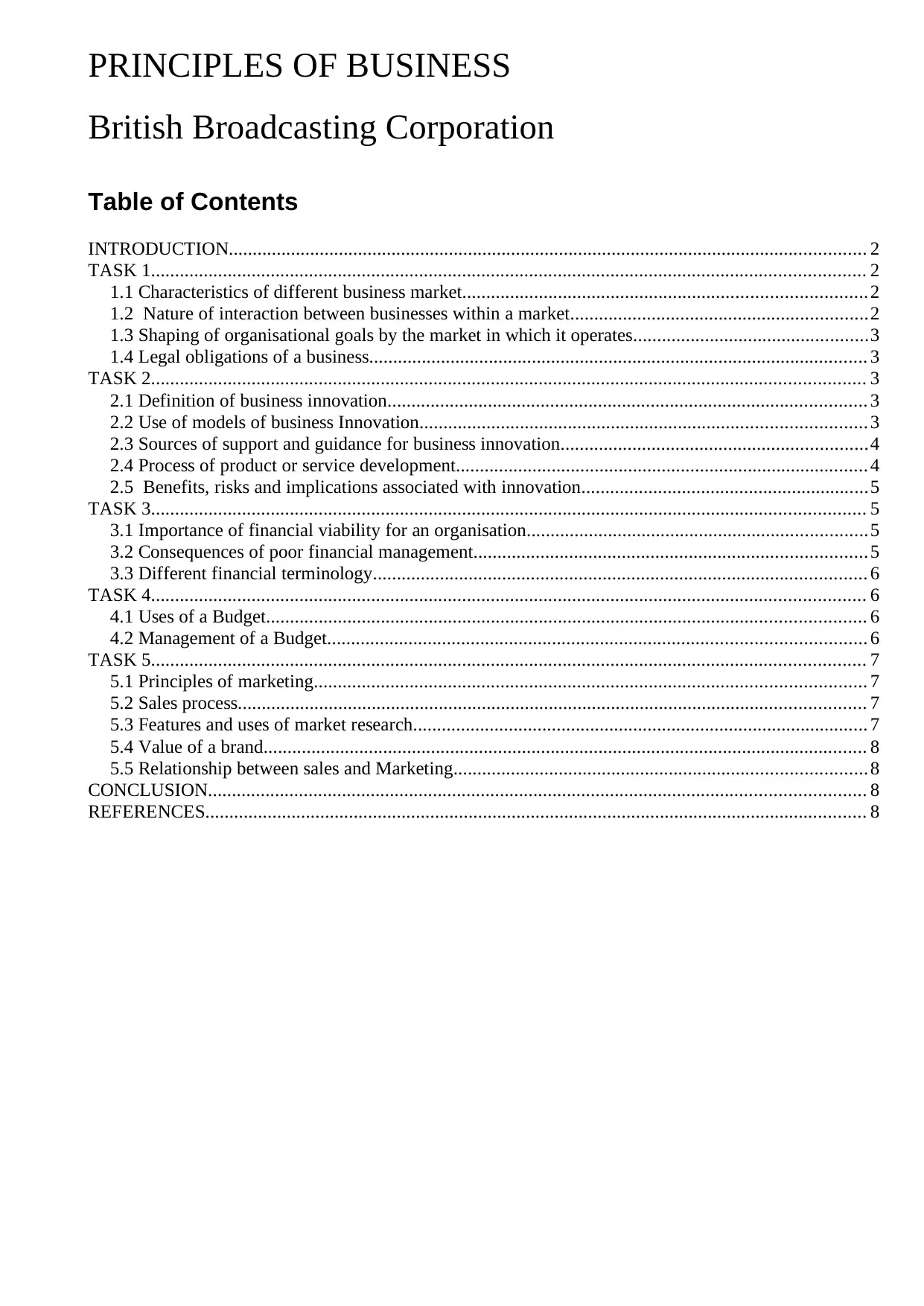
PRINCIPLES OF BUSINESS
British Broadcasting Corporation
Table of Contents
INTRODUCTION..................................................................................................................................... 2
TASK 1..................................................................................................................................................... 2
1.1 Characteristics of different business market....................................................................................2
1.2 Nature of interaction between businesses within a market..............................................................2
1.3 Shaping of organisational goals by the market in which it operates.................................................3
1.4 Legal obligations of a business........................................................................................................ 3
TASK 2..................................................................................................................................................... 3
2.1 Definition of business innovation.................................................................................................... 3
2.2 Use of models of business Innovation............................................................................................. 3
2.3 Sources of support and guidance for business innovation................................................................4
2.4 Process of product or service development...................................................................................... 4
2.5 Benefits, risks and implications associated with innovation............................................................5
TASK 3..................................................................................................................................................... 5
3.1 Importance of financial viability for an organisation.......................................................................5
3.2 Consequences of poor financial management.................................................................................. 5
3.3 Different financial terminology....................................................................................................... 6
TASK 4..................................................................................................................................................... 6
4.1 Uses of a Budget............................................................................................................................. 6
4.2 Management of a Budget................................................................................................................ 6
TASK 5..................................................................................................................................................... 7
5.1 Principles of marketing................................................................................................................... 7
5.2 Sales process................................................................................................................................... 7
5.3 Features and uses of market research............................................................................................... 7
5.4 Value of a brand.............................................................................................................................. 8
5.5 Relationship between sales and Marketing...................................................................................... 8
CONCLUSION......................................................................................................................................... 8
REFERENCES.......................................................................................................................................... 8
British Broadcasting Corporation
Table of Contents
INTRODUCTION..................................................................................................................................... 2
TASK 1..................................................................................................................................................... 2
1.1 Characteristics of different business market....................................................................................2
1.2 Nature of interaction between businesses within a market..............................................................2
1.3 Shaping of organisational goals by the market in which it operates.................................................3
1.4 Legal obligations of a business........................................................................................................ 3
TASK 2..................................................................................................................................................... 3
2.1 Definition of business innovation.................................................................................................... 3
2.2 Use of models of business Innovation............................................................................................. 3
2.3 Sources of support and guidance for business innovation................................................................4
2.4 Process of product or service development...................................................................................... 4
2.5 Benefits, risks and implications associated with innovation............................................................5
TASK 3..................................................................................................................................................... 5
3.1 Importance of financial viability for an organisation.......................................................................5
3.2 Consequences of poor financial management.................................................................................. 5
3.3 Different financial terminology....................................................................................................... 6
TASK 4..................................................................................................................................................... 6
4.1 Uses of a Budget............................................................................................................................. 6
4.2 Management of a Budget................................................................................................................ 6
TASK 5..................................................................................................................................................... 7
5.1 Principles of marketing................................................................................................................... 7
5.2 Sales process................................................................................................................................... 7
5.3 Features and uses of market research............................................................................................... 7
5.4 Value of a brand.............................................................................................................................. 8
5.5 Relationship between sales and Marketing...................................................................................... 8
CONCLUSION......................................................................................................................................... 8
REFERENCES.......................................................................................................................................... 8
Paraphrase This Document
Need a fresh take? Get an instant paraphrase of this document with our AI Paraphraser
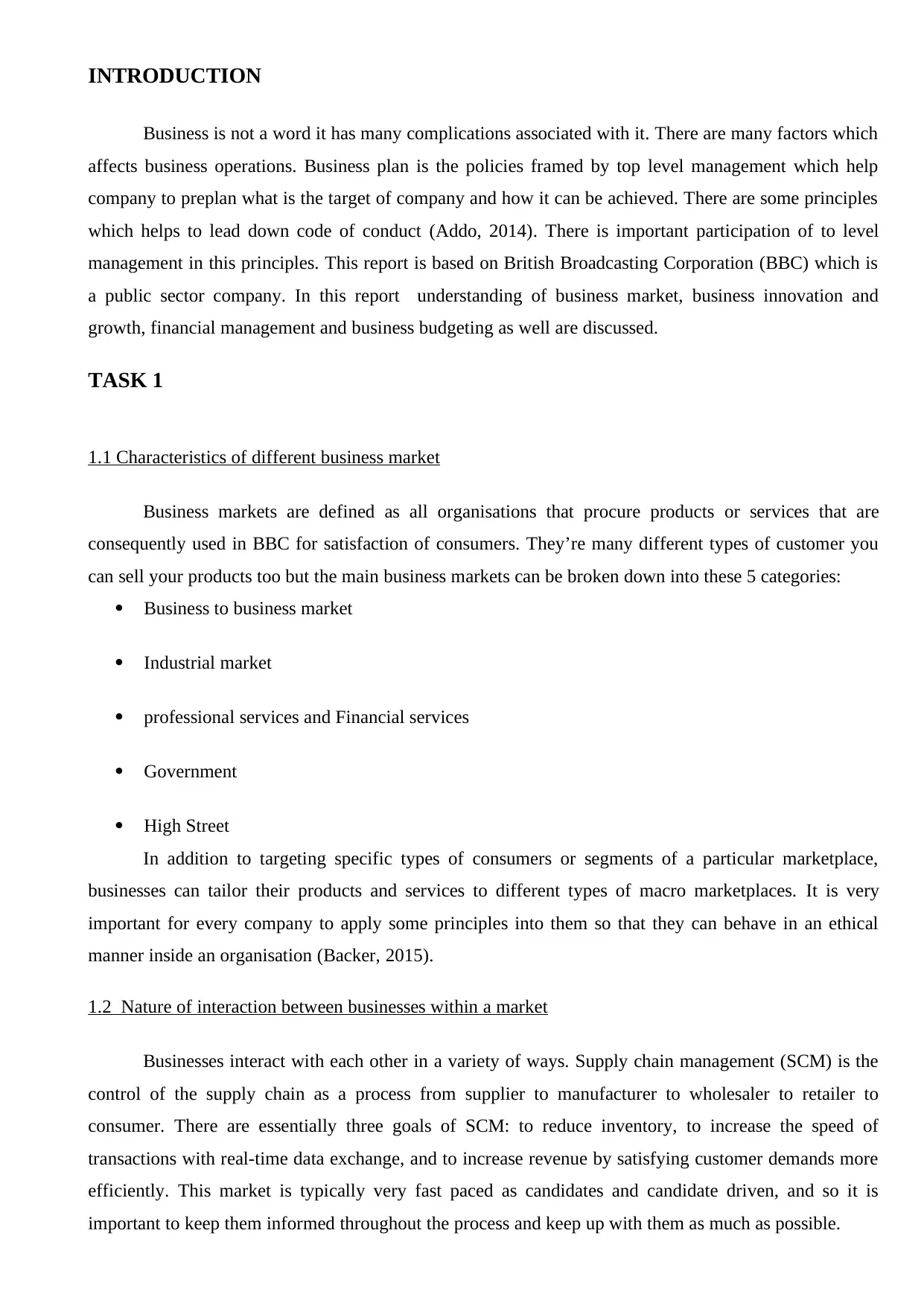
INTRODUCTION
Business is not a word it has many complications associated with it. There are many factors which
affects business operations. Business plan is the policies framed by top level management which help
company to preplan what is the target of company and how it can be achieved. There are some principles
which helps to lead down code of conduct (Addo, 2014). There is important participation of to level
management in this principles. This report is based on British Broadcasting Corporation (BBC) which is
a public sector company. In this report understanding of business market, business innovation and
growth, financial management and business budgeting as well are discussed.
TASK 1
1.1 Characteristics of different business market
Business markets are defined as all organisations that procure products or services that are
consequently used in BBC for satisfaction of consumers. They’re many different types of customer you
can sell your products too but the main business markets can be broken down into these 5 categories:
Business to business market
Industrial market
professional services and Financial services
Government
High Street
In addition to targeting specific types of consumers or segments of a particular marketplace,
businesses can tailor their products and services to different types of macro marketplaces. It is very
important for every company to apply some principles into them so that they can behave in an ethical
manner inside an organisation (Backer, 2015).
1.2 Nature of interaction between businesses within a market
Businesses interact with each other in a variety of ways. Supply chain management (SCM) is the
control of the supply chain as a process from supplier to manufacturer to wholesaler to retailer to
consumer. There are essentially three goals of SCM: to reduce inventory, to increase the speed of
transactions with real-time data exchange, and to increase revenue by satisfying customer demands more
efficiently. This market is typically very fast paced as candidates and candidate driven, and so it is
important to keep them informed throughout the process and keep up with them as much as possible.
Business is not a word it has many complications associated with it. There are many factors which
affects business operations. Business plan is the policies framed by top level management which help
company to preplan what is the target of company and how it can be achieved. There are some principles
which helps to lead down code of conduct (Addo, 2014). There is important participation of to level
management in this principles. This report is based on British Broadcasting Corporation (BBC) which is
a public sector company. In this report understanding of business market, business innovation and
growth, financial management and business budgeting as well are discussed.
TASK 1
1.1 Characteristics of different business market
Business markets are defined as all organisations that procure products or services that are
consequently used in BBC for satisfaction of consumers. They’re many different types of customer you
can sell your products too but the main business markets can be broken down into these 5 categories:
Business to business market
Industrial market
professional services and Financial services
Government
High Street
In addition to targeting specific types of consumers or segments of a particular marketplace,
businesses can tailor their products and services to different types of macro marketplaces. It is very
important for every company to apply some principles into them so that they can behave in an ethical
manner inside an organisation (Backer, 2015).
1.2 Nature of interaction between businesses within a market
Businesses interact with each other in a variety of ways. Supply chain management (SCM) is the
control of the supply chain as a process from supplier to manufacturer to wholesaler to retailer to
consumer. There are essentially three goals of SCM: to reduce inventory, to increase the speed of
transactions with real-time data exchange, and to increase revenue by satisfying customer demands more
efficiently. This market is typically very fast paced as candidates and candidate driven, and so it is
important to keep them informed throughout the process and keep up with them as much as possible.
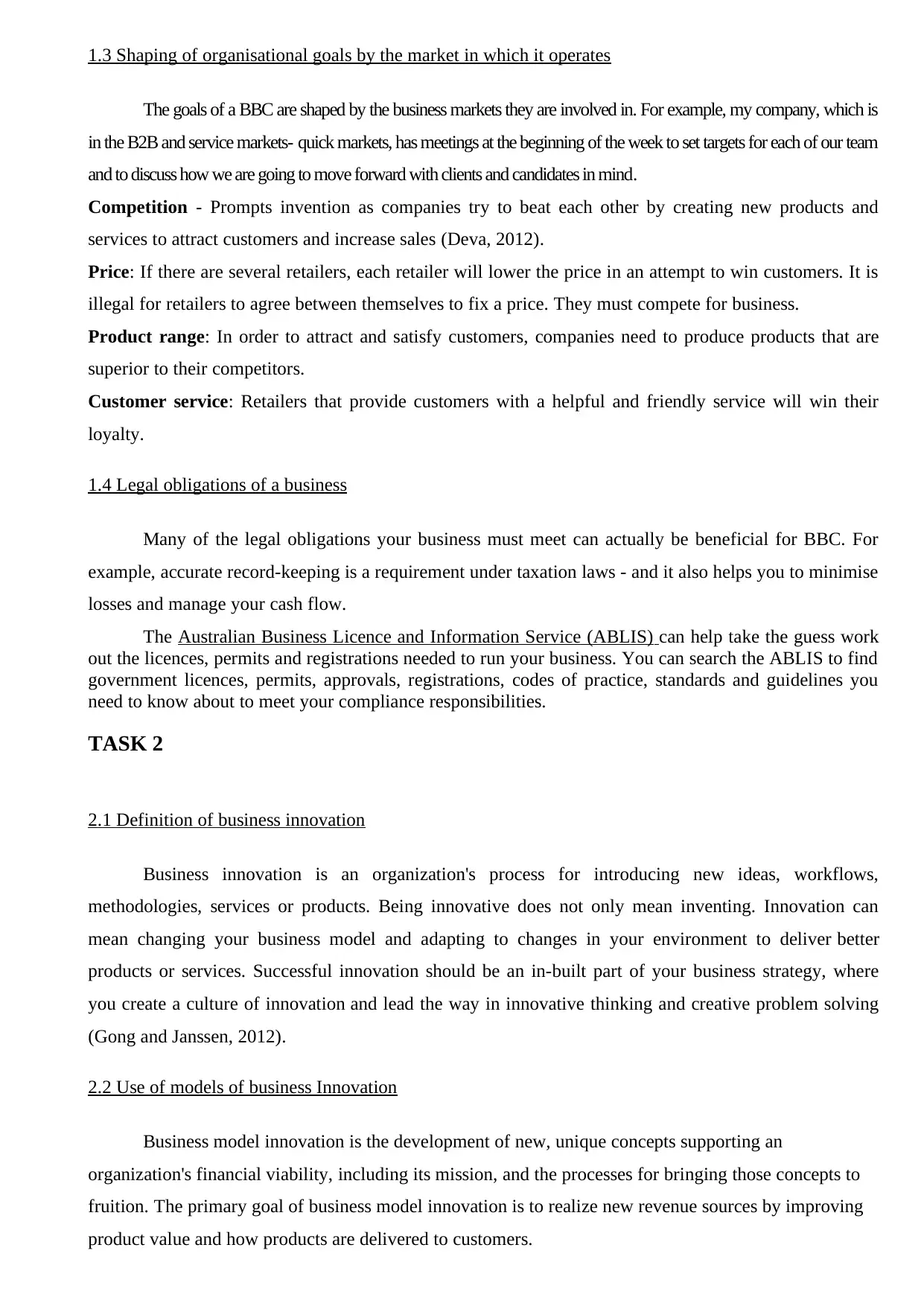
1.3 Shaping of organisational goals by the market in which it operates
The goals of a BBC are shaped by the business markets they are involved in. For example, my company, which is
in the B2B and service markets- quick markets, has meetings at the beginning of the week to set targets for each of our team
and to discuss how we are going to move forward with clients and candidates in mind.
Competition - Prompts invention as companies try to beat each other by creating new products and
services to attract customers and increase sales (Deva, 2012).
Price: If there are several retailers, each retailer will lower the price in an attempt to win customers. It is
illegal for retailers to agree between themselves to fix a price. They must compete for business.
Product range: In order to attract and satisfy customers, companies need to produce products that are
superior to their competitors.
Customer service: Retailers that provide customers with a helpful and friendly service will win their
loyalty.
1.4 Legal obligations of a business
Many of the legal obligations your business must meet can actually be beneficial for BBC. For
example, accurate record-keeping is a requirement under taxation laws - and it also helps you to minimise
losses and manage your cash flow.
The Australian Business Licence and Information Service (ABLIS) can help take the guess work
out the licences, permits and registrations needed to run your business. You can search the ABLIS to find
government licences, permits, approvals, registrations, codes of practice, standards and guidelines you
need to know about to meet your compliance responsibilities.
TASK 2
2.1 Definition of business innovation
Business innovation is an organization's process for introducing new ideas, workflows,
methodologies, services or products. Being innovative does not only mean inventing. Innovation can
mean changing your business model and adapting to changes in your environment to deliver better
products or services. Successful innovation should be an in-built part of your business strategy, where
you create a culture of innovation and lead the way in innovative thinking and creative problem solving
(Gong and Janssen, 2012).
2.2 Use of models of business Innovation
Business model innovation is the development of new, unique concepts supporting an
organization's financial viability, including its mission, and the processes for bringing those concepts to
fruition. The primary goal of business model innovation is to realize new revenue sources by improving
product value and how products are delivered to customers.
The goals of a BBC are shaped by the business markets they are involved in. For example, my company, which is
in the B2B and service markets- quick markets, has meetings at the beginning of the week to set targets for each of our team
and to discuss how we are going to move forward with clients and candidates in mind.
Competition - Prompts invention as companies try to beat each other by creating new products and
services to attract customers and increase sales (Deva, 2012).
Price: If there are several retailers, each retailer will lower the price in an attempt to win customers. It is
illegal for retailers to agree between themselves to fix a price. They must compete for business.
Product range: In order to attract and satisfy customers, companies need to produce products that are
superior to their competitors.
Customer service: Retailers that provide customers with a helpful and friendly service will win their
loyalty.
1.4 Legal obligations of a business
Many of the legal obligations your business must meet can actually be beneficial for BBC. For
example, accurate record-keeping is a requirement under taxation laws - and it also helps you to minimise
losses and manage your cash flow.
The Australian Business Licence and Information Service (ABLIS) can help take the guess work
out the licences, permits and registrations needed to run your business. You can search the ABLIS to find
government licences, permits, approvals, registrations, codes of practice, standards and guidelines you
need to know about to meet your compliance responsibilities.
TASK 2
2.1 Definition of business innovation
Business innovation is an organization's process for introducing new ideas, workflows,
methodologies, services or products. Being innovative does not only mean inventing. Innovation can
mean changing your business model and adapting to changes in your environment to deliver better
products or services. Successful innovation should be an in-built part of your business strategy, where
you create a culture of innovation and lead the way in innovative thinking and creative problem solving
(Gong and Janssen, 2012).
2.2 Use of models of business Innovation
Business model innovation is the development of new, unique concepts supporting an
organization's financial viability, including its mission, and the processes for bringing those concepts to
fruition. The primary goal of business model innovation is to realize new revenue sources by improving
product value and how products are delivered to customers.
⊘ This is a preview!⊘
Do you want full access?
Subscribe today to unlock all pages.

Trusted by 1+ million students worldwide
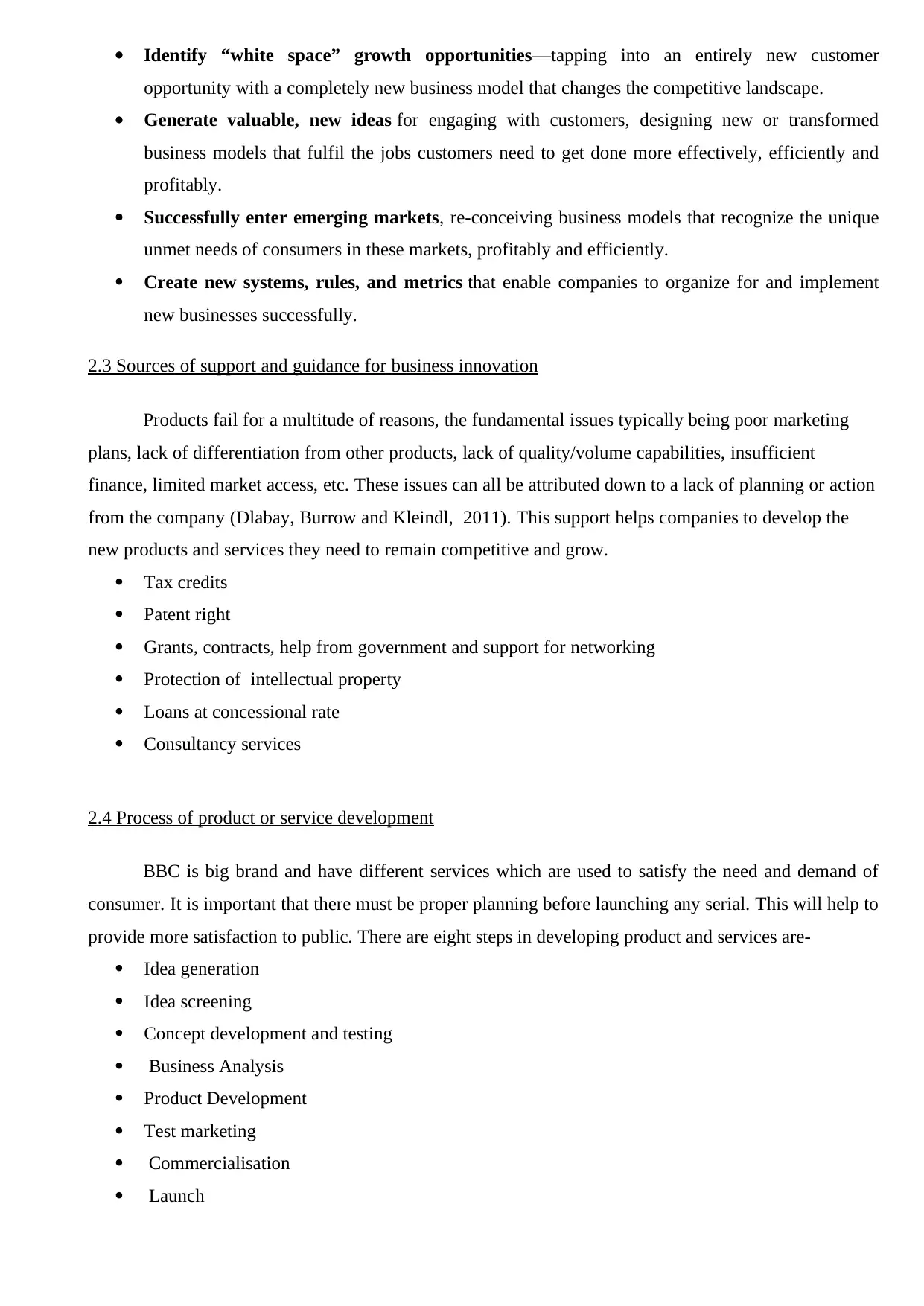
Identify “white space” growth opportunities—tapping into an entirely new customer
opportunity with a completely new business model that changes the competitive landscape.
Generate valuable, new ideas for engaging with customers, designing new or transformed
business models that fulfil the jobs customers need to get done more effectively, efficiently and
profitably.
Successfully enter emerging markets, re-conceiving business models that recognize the unique
unmet needs of consumers in these markets, profitably and efficiently.
Create new systems, rules, and metrics that enable companies to organize for and implement
new businesses successfully.
2.3 Sources of support and guidance for business innovation
Products fail for a multitude of reasons, the fundamental issues typically being poor marketing
plans, lack of differentiation from other products, lack of quality/volume capabilities, insufficient
finance, limited market access, etc. These issues can all be attributed down to a lack of planning or action
from the company (Dlabay, Burrow and Kleindl, 2011). This support helps companies to develop the
new products and services they need to remain competitive and grow.
Tax credits
Patent right
Grants, contracts, help from government and support for networking
Protection of intellectual property
Loans at concessional rate
Consultancy services
2.4 Process of product or service development
BBC is big brand and have different services which are used to satisfy the need and demand of
consumer. It is important that there must be proper planning before launching any serial. This will help to
provide more satisfaction to public. There are eight steps in developing product and services are-
Idea generation
Idea screening
Concept development and testing
Business Analysis
Product Development
Test marketing
Commercialisation
Launch
opportunity with a completely new business model that changes the competitive landscape.
Generate valuable, new ideas for engaging with customers, designing new or transformed
business models that fulfil the jobs customers need to get done more effectively, efficiently and
profitably.
Successfully enter emerging markets, re-conceiving business models that recognize the unique
unmet needs of consumers in these markets, profitably and efficiently.
Create new systems, rules, and metrics that enable companies to organize for and implement
new businesses successfully.
2.3 Sources of support and guidance for business innovation
Products fail for a multitude of reasons, the fundamental issues typically being poor marketing
plans, lack of differentiation from other products, lack of quality/volume capabilities, insufficient
finance, limited market access, etc. These issues can all be attributed down to a lack of planning or action
from the company (Dlabay, Burrow and Kleindl, 2011). This support helps companies to develop the
new products and services they need to remain competitive and grow.
Tax credits
Patent right
Grants, contracts, help from government and support for networking
Protection of intellectual property
Loans at concessional rate
Consultancy services
2.4 Process of product or service development
BBC is big brand and have different services which are used to satisfy the need and demand of
consumer. It is important that there must be proper planning before launching any serial. This will help to
provide more satisfaction to public. There are eight steps in developing product and services are-
Idea generation
Idea screening
Concept development and testing
Business Analysis
Product Development
Test marketing
Commercialisation
Launch
Paraphrase This Document
Need a fresh take? Get an instant paraphrase of this document with our AI Paraphraser
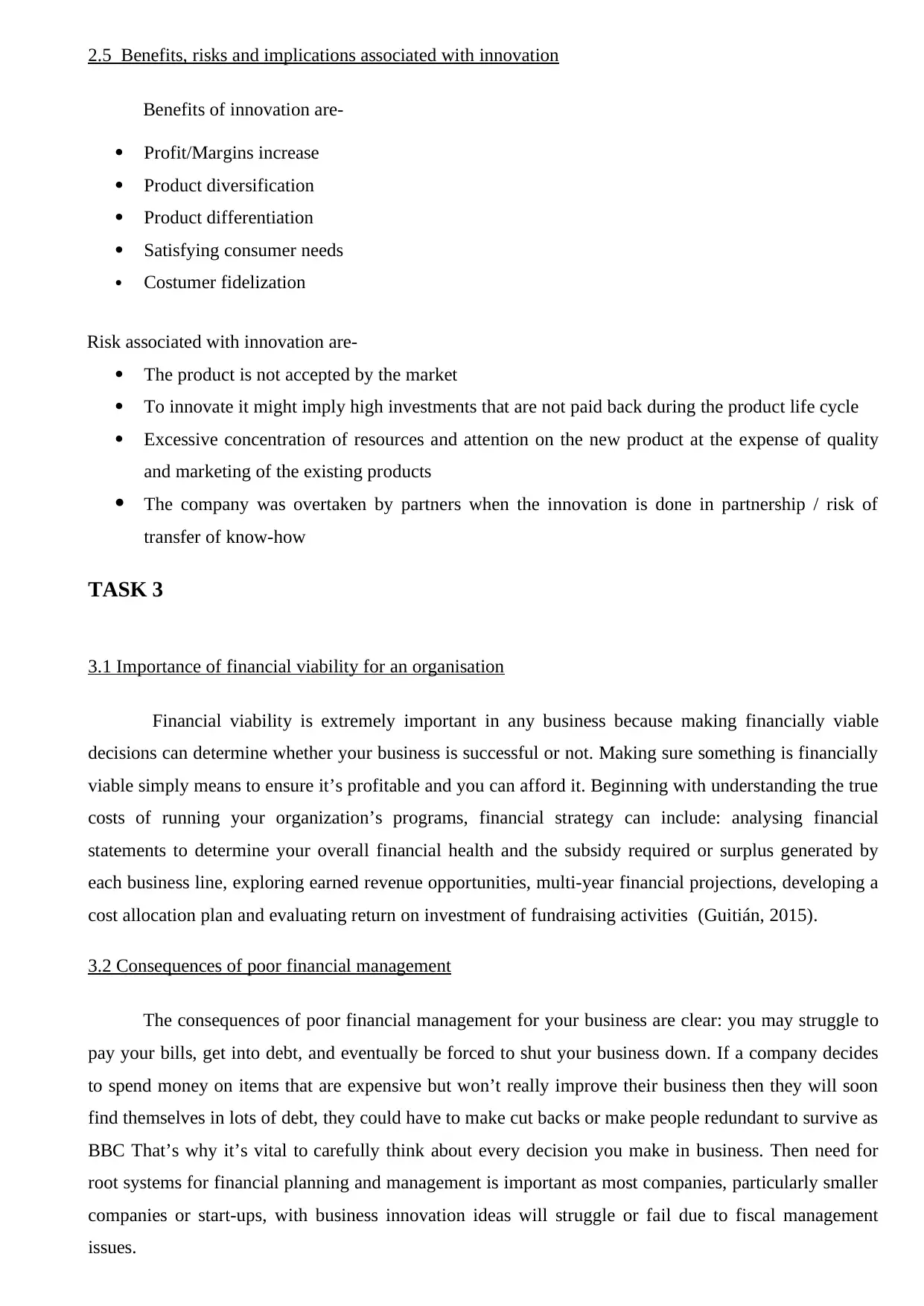
2.5 Benefits, risks and implications associated with innovation
Benefits of innovation are-
Profit/Margins increase
Product diversification
Product differentiation
Satisfying consumer needs
Costumer fidelization
Risk associated with innovation are-
The product is not accepted by the market
To innovate it might imply high investments that are not paid back during the product life cycle
Excessive concentration of resources and attention on the new product at the expense of quality
and marketing of the existing products
The company was overtaken by partners when the innovation is done in partnership / risk of
transfer of know-how
TASK 3
3.1 Importance of financial viability for an organisation
Financial viability is extremely important in any business because making financially viable
decisions can determine whether your business is successful or not. Making sure something is financially
viable simply means to ensure it’s profitable and you can afford it. Beginning with understanding the true
costs of running your organization’s programs, financial strategy can include: analysing financial
statements to determine your overall financial health and the subsidy required or surplus generated by
each business line, exploring earned revenue opportunities, multi-year financial projections, developing a
cost allocation plan and evaluating return on investment of fundraising activities (Guitián, 2015).
3.2 Consequences of poor financial management
The consequences of poor financial management for your business are clear: you may struggle to
pay your bills, get into debt, and eventually be forced to shut your business down. If a company decides
to spend money on items that are expensive but won’t really improve their business then they will soon
find themselves in lots of debt, they could have to make cut backs or make people redundant to survive as
BBC That’s why it’s vital to carefully think about every decision you make in business. Then need for
root systems for financial planning and management is important as most companies, particularly smaller
companies or start-ups, with business innovation ideas will struggle or fail due to fiscal management
issues.
Benefits of innovation are-
Profit/Margins increase
Product diversification
Product differentiation
Satisfying consumer needs
Costumer fidelization
Risk associated with innovation are-
The product is not accepted by the market
To innovate it might imply high investments that are not paid back during the product life cycle
Excessive concentration of resources and attention on the new product at the expense of quality
and marketing of the existing products
The company was overtaken by partners when the innovation is done in partnership / risk of
transfer of know-how
TASK 3
3.1 Importance of financial viability for an organisation
Financial viability is extremely important in any business because making financially viable
decisions can determine whether your business is successful or not. Making sure something is financially
viable simply means to ensure it’s profitable and you can afford it. Beginning with understanding the true
costs of running your organization’s programs, financial strategy can include: analysing financial
statements to determine your overall financial health and the subsidy required or surplus generated by
each business line, exploring earned revenue opportunities, multi-year financial projections, developing a
cost allocation plan and evaluating return on investment of fundraising activities (Guitián, 2015).
3.2 Consequences of poor financial management
The consequences of poor financial management for your business are clear: you may struggle to
pay your bills, get into debt, and eventually be forced to shut your business down. If a company decides
to spend money on items that are expensive but won’t really improve their business then they will soon
find themselves in lots of debt, they could have to make cut backs or make people redundant to survive as
BBC That’s why it’s vital to carefully think about every decision you make in business. Then need for
root systems for financial planning and management is important as most companies, particularly smaller
companies or start-ups, with business innovation ideas will struggle or fail due to fiscal management
issues.
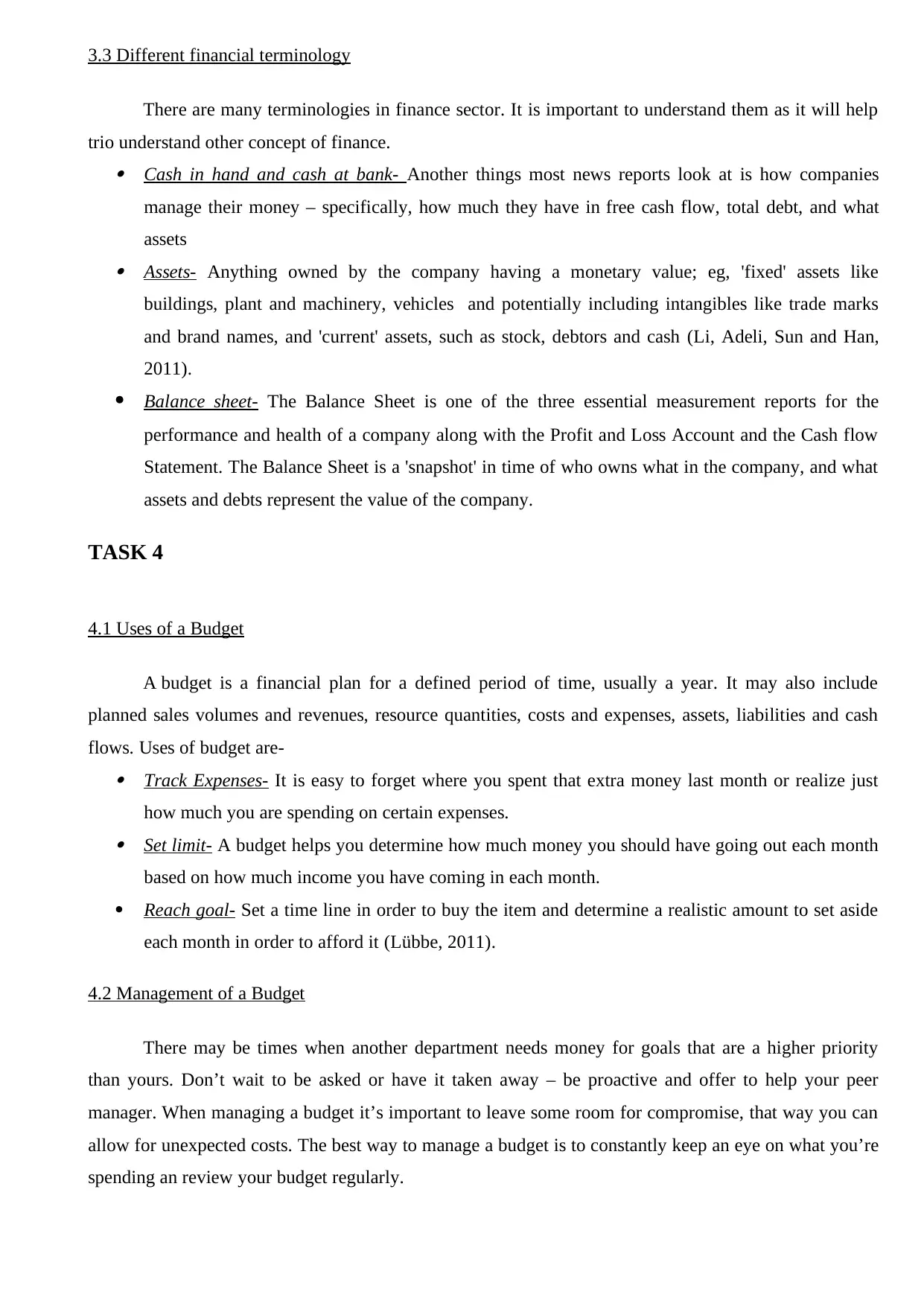
3.3 Different financial terminology
There are many terminologies in finance sector. It is important to understand them as it will help
trio understand other concept of finance. Cash in hand and cash at bank- Another things most news reports look at is how companies
manage their money – specifically, how much they have in free cash flow, total debt, and what
assets Assets- Anything owned by the company having a monetary value; eg, 'fixed' assets like
buildings, plant and machinery, vehicles and potentially including intangibles like trade marks
and brand names, and 'current' assets, such as stock, debtors and cash (Li, Adeli, Sun and Han,
2011).
Balance sheet- The Balance Sheet is one of the three essential measurement reports for the
performance and health of a company along with the Profit and Loss Account and the Cash flow
Statement. The Balance Sheet is a 'snapshot' in time of who owns what in the company, and what
assets and debts represent the value of the company.
TASK 4
4.1 Uses of a Budget
A budget is a financial plan for a defined period of time, usually a year. It may also include
planned sales volumes and revenues, resource quantities, costs and expenses, assets, liabilities and cash
flows. Uses of budget are- Track Expenses- It is easy to forget where you spent that extra money last month or realize just
how much you are spending on certain expenses. Set limit- A budget helps you determine how much money you should have going out each month
based on how much income you have coming in each month.
Reach goal- Set a time line in order to buy the item and determine a realistic amount to set aside
each month in order to afford it (Lübbe, 2011).
4.2 Management of a Budget
There may be times when another department needs money for goals that are a higher priority
than yours. Don’t wait to be asked or have it taken away – be proactive and offer to help your peer
manager. When managing a budget it’s important to leave some room for compromise, that way you can
allow for unexpected costs. The best way to manage a budget is to constantly keep an eye on what you’re
spending an review your budget regularly.
There are many terminologies in finance sector. It is important to understand them as it will help
trio understand other concept of finance. Cash in hand and cash at bank- Another things most news reports look at is how companies
manage their money – specifically, how much they have in free cash flow, total debt, and what
assets Assets- Anything owned by the company having a monetary value; eg, 'fixed' assets like
buildings, plant and machinery, vehicles and potentially including intangibles like trade marks
and brand names, and 'current' assets, such as stock, debtors and cash (Li, Adeli, Sun and Han,
2011).
Balance sheet- The Balance Sheet is one of the three essential measurement reports for the
performance and health of a company along with the Profit and Loss Account and the Cash flow
Statement. The Balance Sheet is a 'snapshot' in time of who owns what in the company, and what
assets and debts represent the value of the company.
TASK 4
4.1 Uses of a Budget
A budget is a financial plan for a defined period of time, usually a year. It may also include
planned sales volumes and revenues, resource quantities, costs and expenses, assets, liabilities and cash
flows. Uses of budget are- Track Expenses- It is easy to forget where you spent that extra money last month or realize just
how much you are spending on certain expenses. Set limit- A budget helps you determine how much money you should have going out each month
based on how much income you have coming in each month.
Reach goal- Set a time line in order to buy the item and determine a realistic amount to set aside
each month in order to afford it (Lübbe, 2011).
4.2 Management of a Budget
There may be times when another department needs money for goals that are a higher priority
than yours. Don’t wait to be asked or have it taken away – be proactive and offer to help your peer
manager. When managing a budget it’s important to leave some room for compromise, that way you can
allow for unexpected costs. The best way to manage a budget is to constantly keep an eye on what you’re
spending an review your budget regularly.
⊘ This is a preview!⊘
Do you want full access?
Subscribe today to unlock all pages.

Trusted by 1+ million students worldwide
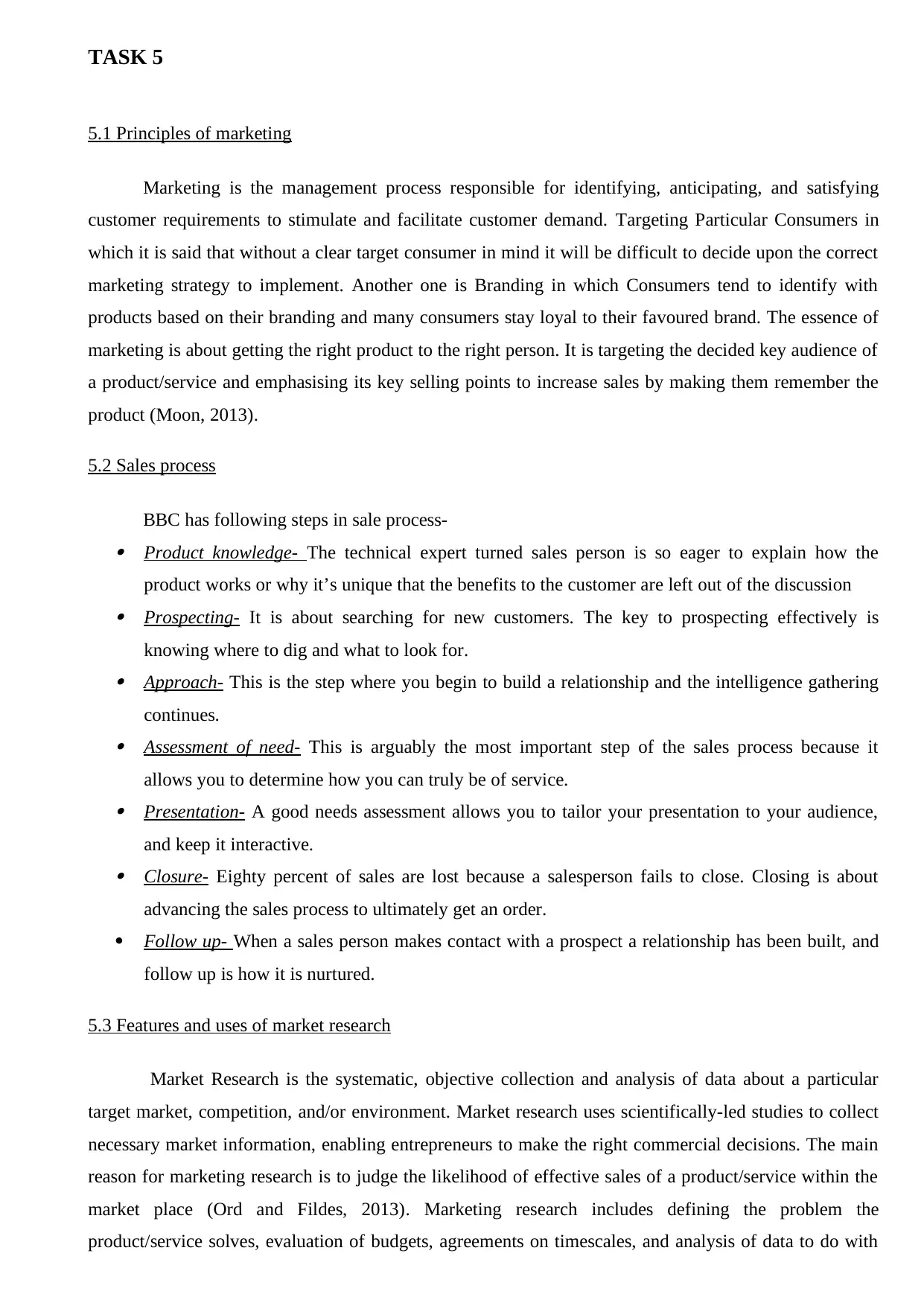
TASK 5
5.1 Principles of marketing
Marketing is the management process responsible for identifying, anticipating, and satisfying
customer requirements to stimulate and facilitate customer demand. Targeting Particular Consumers in
which it is said that without a clear target consumer in mind it will be difficult to decide upon the correct
marketing strategy to implement. Another one is Branding in which Consumers tend to identify with
products based on their branding and many consumers stay loyal to their favoured brand. The essence of
marketing is about getting the right product to the right person. It is targeting the decided key audience of
a product/service and emphasising its key selling points to increase sales by making them remember the
product (Moon, 2013).
5.2 Sales process
BBC has following steps in sale process- Product knowledge- The technical expert turned sales person is so eager to explain how the
product works or why it’s unique that the benefits to the customer are left out of the discussion Prospecting- It is about searching for new customers. The key to prospecting effectively is
knowing where to dig and what to look for. Approach- This is the step where you begin to build a relationship and the intelligence gathering
continues. Assessment of need- This is arguably the most important step of the sales process because it
allows you to determine how you can truly be of service. Presentation- A good needs assessment allows you to tailor your presentation to your audience,
and keep it interactive. Closure- Eighty percent of sales are lost because a salesperson fails to close. Closing is about
advancing the sales process to ultimately get an order.
Follow up- When a sales person makes contact with a prospect a relationship has been built, and
follow up is how it is nurtured.
5.3 Features and uses of market research
Market Research is the systematic, objective collection and analysis of data about a particular
target market, competition, and/or environment. Market research uses scientifically-led studies to collect
necessary market information, enabling entrepreneurs to make the right commercial decisions. The main
reason for marketing research is to judge the likelihood of effective sales of a product/service within the
market place (Ord and Fildes, 2013). Marketing research includes defining the problem the
product/service solves, evaluation of budgets, agreements on timescales, and analysis of data to do with
5.1 Principles of marketing
Marketing is the management process responsible for identifying, anticipating, and satisfying
customer requirements to stimulate and facilitate customer demand. Targeting Particular Consumers in
which it is said that without a clear target consumer in mind it will be difficult to decide upon the correct
marketing strategy to implement. Another one is Branding in which Consumers tend to identify with
products based on their branding and many consumers stay loyal to their favoured brand. The essence of
marketing is about getting the right product to the right person. It is targeting the decided key audience of
a product/service and emphasising its key selling points to increase sales by making them remember the
product (Moon, 2013).
5.2 Sales process
BBC has following steps in sale process- Product knowledge- The technical expert turned sales person is so eager to explain how the
product works or why it’s unique that the benefits to the customer are left out of the discussion Prospecting- It is about searching for new customers. The key to prospecting effectively is
knowing where to dig and what to look for. Approach- This is the step where you begin to build a relationship and the intelligence gathering
continues. Assessment of need- This is arguably the most important step of the sales process because it
allows you to determine how you can truly be of service. Presentation- A good needs assessment allows you to tailor your presentation to your audience,
and keep it interactive. Closure- Eighty percent of sales are lost because a salesperson fails to close. Closing is about
advancing the sales process to ultimately get an order.
Follow up- When a sales person makes contact with a prospect a relationship has been built, and
follow up is how it is nurtured.
5.3 Features and uses of market research
Market Research is the systematic, objective collection and analysis of data about a particular
target market, competition, and/or environment. Market research uses scientifically-led studies to collect
necessary market information, enabling entrepreneurs to make the right commercial decisions. The main
reason for marketing research is to judge the likelihood of effective sales of a product/service within the
market place (Ord and Fildes, 2013). Marketing research includes defining the problem the
product/service solves, evaluation of budgets, agreements on timescales, and analysis of data to do with
Paraphrase This Document
Need a fresh take? Get an instant paraphrase of this document with our AI Paraphraser
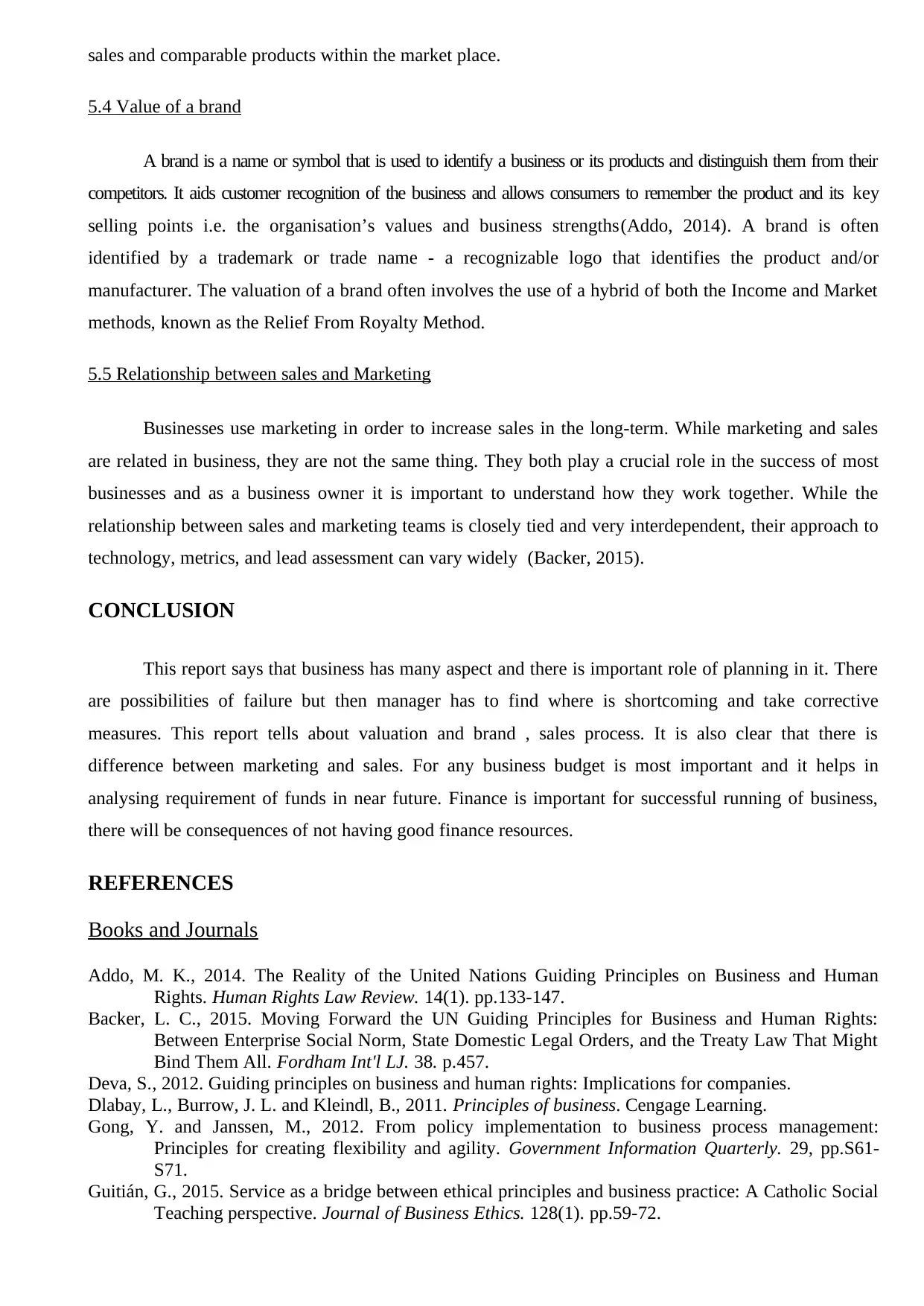
sales and comparable products within the market place.
5.4 Value of a brand
A brand is a name or symbol that is used to identify a business or its products and distinguish them from their
competitors. It aids customer recognition of the business and allows consumers to remember the product and its key
selling points i.e. the organisation’s values and business strengths(Addo, 2014). A brand is often
identified by a trademark or trade name - a recognizable logo that identifies the product and/or
manufacturer. The valuation of a brand often involves the use of a hybrid of both the Income and Market
methods, known as the Relief From Royalty Method.
5.5 Relationship between sales and Marketing
Businesses use marketing in order to increase sales in the long-term. While marketing and sales
are related in business, they are not the same thing. They both play a crucial role in the success of most
businesses and as a business owner it is important to understand how they work together. While the
relationship between sales and marketing teams is closely tied and very interdependent, their approach to
technology, metrics, and lead assessment can vary widely (Backer, 2015).
CONCLUSION
This report says that business has many aspect and there is important role of planning in it. There
are possibilities of failure but then manager has to find where is shortcoming and take corrective
measures. This report tells about valuation and brand , sales process. It is also clear that there is
difference between marketing and sales. For any business budget is most important and it helps in
analysing requirement of funds in near future. Finance is important for successful running of business,
there will be consequences of not having good finance resources.
REFERENCES
Books and Journals
Addo, M. K., 2014. The Reality of the United Nations Guiding Principles on Business and Human
Rights. Human Rights Law Review. 14(1). pp.133-147.
Backer, L. C., 2015. Moving Forward the UN Guiding Principles for Business and Human Rights:
Between Enterprise Social Norm, State Domestic Legal Orders, and the Treaty Law That Might
Bind Them All. Fordham Int'l LJ. 38. p.457.
Deva, S., 2012. Guiding principles on business and human rights: Implications for companies.
Dlabay, L., Burrow, J. L. and Kleindl, B., 2011. Principles of business. Cengage Learning.
Gong, Y. and Janssen, M., 2012. From policy implementation to business process management:
Principles for creating flexibility and agility. Government Information Quarterly. 29, pp.S61-
S71.
Guitián, G., 2015. Service as a bridge between ethical principles and business practice: A Catholic Social
Teaching perspective. Journal of Business Ethics. 128(1). pp.59-72.
5.4 Value of a brand
A brand is a name or symbol that is used to identify a business or its products and distinguish them from their
competitors. It aids customer recognition of the business and allows consumers to remember the product and its key
selling points i.e. the organisation’s values and business strengths(Addo, 2014). A brand is often
identified by a trademark or trade name - a recognizable logo that identifies the product and/or
manufacturer. The valuation of a brand often involves the use of a hybrid of both the Income and Market
methods, known as the Relief From Royalty Method.
5.5 Relationship between sales and Marketing
Businesses use marketing in order to increase sales in the long-term. While marketing and sales
are related in business, they are not the same thing. They both play a crucial role in the success of most
businesses and as a business owner it is important to understand how they work together. While the
relationship between sales and marketing teams is closely tied and very interdependent, their approach to
technology, metrics, and lead assessment can vary widely (Backer, 2015).
CONCLUSION
This report says that business has many aspect and there is important role of planning in it. There
are possibilities of failure but then manager has to find where is shortcoming and take corrective
measures. This report tells about valuation and brand , sales process. It is also clear that there is
difference between marketing and sales. For any business budget is most important and it helps in
analysing requirement of funds in near future. Finance is important for successful running of business,
there will be consequences of not having good finance resources.
REFERENCES
Books and Journals
Addo, M. K., 2014. The Reality of the United Nations Guiding Principles on Business and Human
Rights. Human Rights Law Review. 14(1). pp.133-147.
Backer, L. C., 2015. Moving Forward the UN Guiding Principles for Business and Human Rights:
Between Enterprise Social Norm, State Domestic Legal Orders, and the Treaty Law That Might
Bind Them All. Fordham Int'l LJ. 38. p.457.
Deva, S., 2012. Guiding principles on business and human rights: Implications for companies.
Dlabay, L., Burrow, J. L. and Kleindl, B., 2011. Principles of business. Cengage Learning.
Gong, Y. and Janssen, M., 2012. From policy implementation to business process management:
Principles for creating flexibility and agility. Government Information Quarterly. 29, pp.S61-
S71.
Guitián, G., 2015. Service as a bridge between ethical principles and business practice: A Catholic Social
Teaching perspective. Journal of Business Ethics. 128(1). pp.59-72.
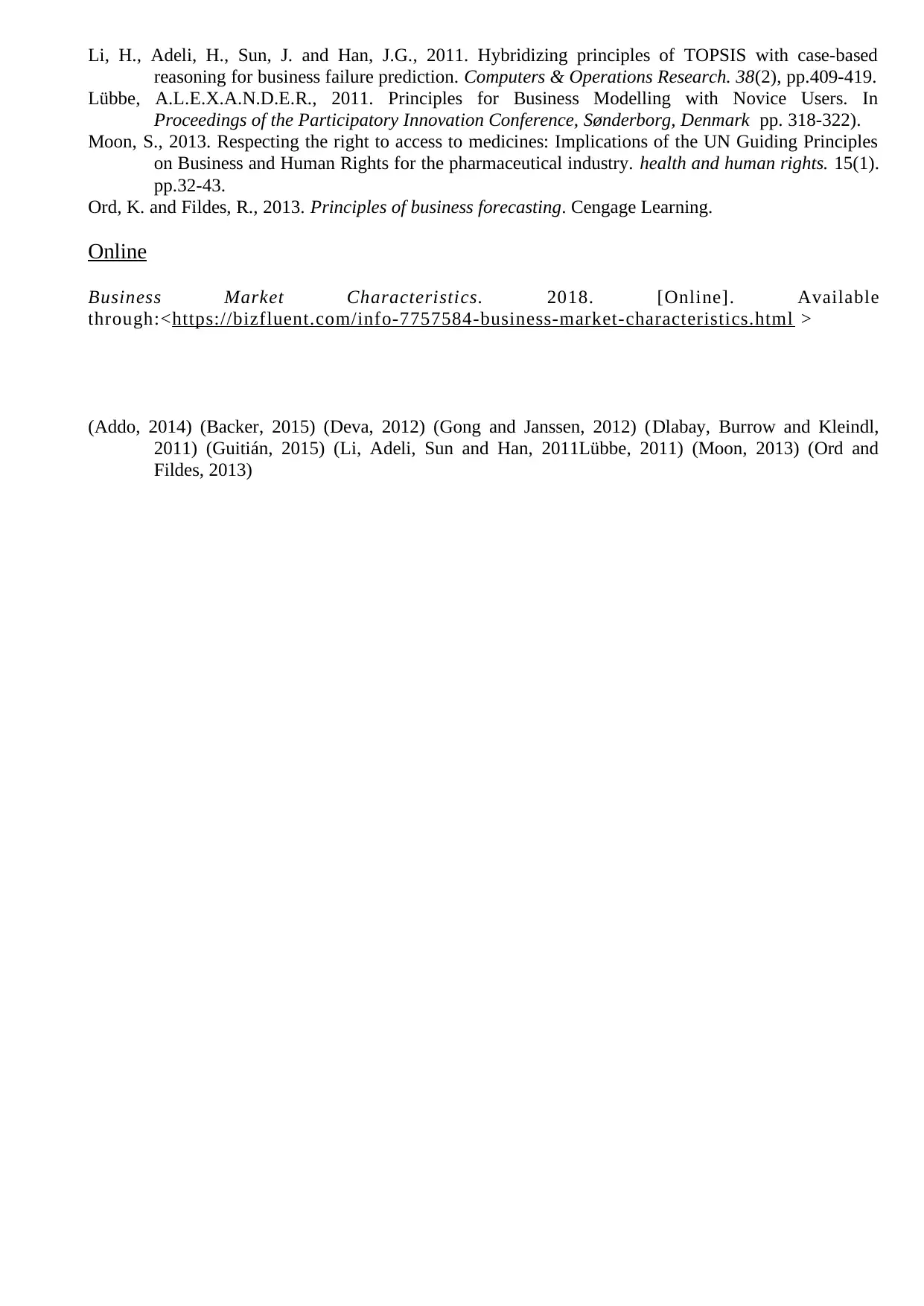
Li, H., Adeli, H., Sun, J. and Han, J.G., 2011. Hybridizing principles of TOPSIS with case-based
reasoning for business failure prediction. Computers & Operations Research. 38(2), pp.409-419.
Lübbe, A.L.E.X.A.N.D.E.R., 2011. Principles for Business Modelling with Novice Users. In
Proceedings of the Participatory Innovation Conference, Sønderborg, Denmark pp. 318-322).
Moon, S., 2013. Respecting the right to access to medicines: Implications of the UN Guiding Principles
on Business and Human Rights for the pharmaceutical industry. health and human rights. 15(1).
pp.32-43.
Ord, K. and Fildes, R., 2013. Principles of business forecasting. Cengage Learning.
Online
Business Market Characteristics. 2018. [Online]. Available
through:<https://bizfluent.com/info-7757584-business-market-characteristics.html >
(Addo, 2014) (Backer, 2015) (Deva, 2012) (Gong and Janssen, 2012) (Dlabay, Burrow and Kleindl,
2011) (Guitián, 2015) (Li, Adeli, Sun and Han, 2011Lübbe, 2011) (Moon, 2013) (Ord and
Fildes, 2013)
reasoning for business failure prediction. Computers & Operations Research. 38(2), pp.409-419.
Lübbe, A.L.E.X.A.N.D.E.R., 2011. Principles for Business Modelling with Novice Users. In
Proceedings of the Participatory Innovation Conference, Sønderborg, Denmark pp. 318-322).
Moon, S., 2013. Respecting the right to access to medicines: Implications of the UN Guiding Principles
on Business and Human Rights for the pharmaceutical industry. health and human rights. 15(1).
pp.32-43.
Ord, K. and Fildes, R., 2013. Principles of business forecasting. Cengage Learning.
Online
Business Market Characteristics. 2018. [Online]. Available
through:<https://bizfluent.com/info-7757584-business-market-characteristics.html >
(Addo, 2014) (Backer, 2015) (Deva, 2012) (Gong and Janssen, 2012) (Dlabay, Burrow and Kleindl,
2011) (Guitián, 2015) (Li, Adeli, Sun and Han, 2011Lübbe, 2011) (Moon, 2013) (Ord and
Fildes, 2013)
⊘ This is a preview!⊘
Do you want full access?
Subscribe today to unlock all pages.

Trusted by 1+ million students worldwide

1 out of 10
Related Documents
Your All-in-One AI-Powered Toolkit for Academic Success.
+13062052269
info@desklib.com
Available 24*7 on WhatsApp / Email
![[object Object]](/_next/static/media/star-bottom.7253800d.svg)
Unlock your academic potential
Copyright © 2020–2025 A2Z Services. All Rights Reserved. Developed and managed by ZUCOL.





